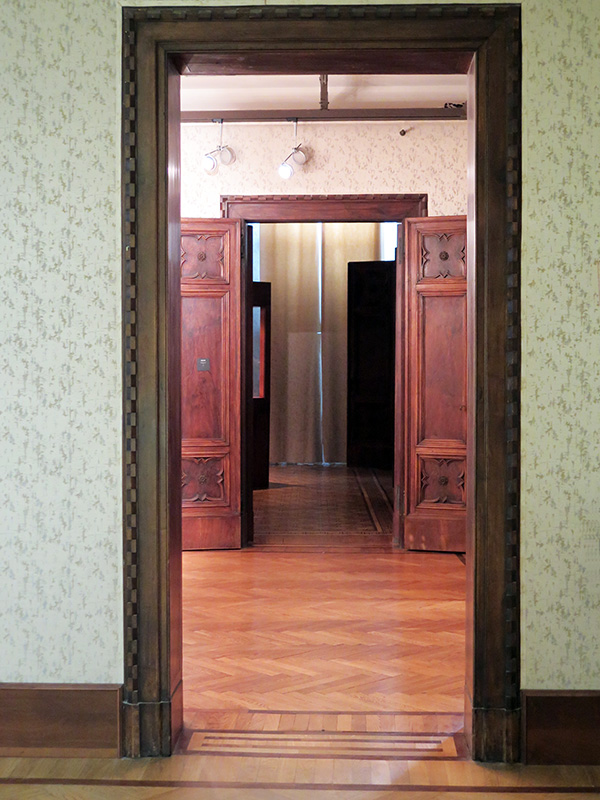
This morning I saw a woman in her 70s with flowers face painted on her face. I overheard that she had a face-painting birthday party for her grandchild on the weekend, and decided to keep the flowers since they were so cheerful. It felt daring and of course I loved it. It also reminded me of the many beige and brown outfits I saw during my travels, something considered elegant and flattering and “feminine”, when really few people can pull it off. Mostly it just makes you somewhat invisible (look at the cover photo….). I so often think about Hannah Arendt donning her lover Heidegger’s favorite brown dress during a reunion after the war. Brown? The color of hamsters and Nazis? Having kept it in the first place?
Paula Becker Modersohn – Old Woman – in her museum in Bremen – the first ever museum built for a female painter!
During a conversation later in the morning a friend and I mused about why women always take themselves back, rather than making themselves visible. in a less literal way as well. Or shall we say “in the linguistic way.” We often devalue ourselves in advance, using hesitating language.
Below is a link to a rather self-helpish, if that’s a word, tutorial, but one that nicely summarizes what psychologists have shown as typically female speech patterns. I copied the most important points for your perusal.
I thought this portrait at the Whitney by John Wilde of his wife Helen (1950) called Work Reconsiderd #1 nicely points the way:
1. Drop the “just:” “I’m just wondering …” “I just think …” “I just want to add …” “Just” demeans what you have to say. “Just” shrinks your power. It’s time to say goodbye to the justs.
2. While you are at it, drop the “actually.” “I actually have a question.” ” I actually want to add something.” “Actually” communicates a sense of surprise that you have something to say. Of course you want to add something. Of course you have questions. There’s nothing surprising about it.
3. Don’t tell us why what you are about to say is likely to be wrong. We are still starting sentences with, “I haven’t researched this much but …” “I’m just thinking off the top of my head but …” “You’ve clearly been studying this longer than I have, but …”
We do this for lots of reasons. We don’t want to appear arrogant. We aren’t totally sure about what we are saying. Or we fear being wrong, and so we buffer the sting of a critical response by saying up front, “I’m not totally standing behind what I’m about to say, but …” Then, no one has the chance to say back, “Well, I know you strongly believe this, but I entirely disagree.”
No matter what the reason, doing this takes away from the power of your voice. Time to change the habit.
4. Don’t tell us you are going to “just take a minute” to say something. Often, in presentations or meetings, I hear women say, “I’d like to ask you to take just a minute to consider this idea” or “Now, I’m going to take just a few minutes to tell you about our product.” Think about how much stronger it sounds to simply say, “I’d like to tell you about our product.”
Go ahead and only take a minute, if that’s appropriate, but skip using the phrase “just a minute” in a talk or presentation. It sounds apologetic and implies that you don’t think what you are about to say is worthy of time and attention.
5. Don’t make your sentences sound like questions. Women often raise the pitch of their voice at the end of a sentence, making it sound like a question. Listen to your own language and that of women around you, and you are likely to notice this everywhere. Unsurprisingly, speaking a statement like a question diminishes its power. Make statements sound like statements; drop the tone lower at the end.
6. Don’t substitute a question for a statement. You might think you are “suggesting” increasing the marketing budget by asking, “What about increasing the marketing budget?” in a meeting, but your colleagues aren’t likely to hear an opinion (and certainly not a well thought-out opinion) in your question. When you have something to say, don’t couch it in a question.
http://www.taramohr.com/8-ways-women-undermine-themselves-with-their-words/
Here’s to strong and colorful women – and those who love blue hats.

Guy Pene Du Bois, Woman with Cigarette (1929) at the Whitney










 It took an incredible amount of work for all the staff to pull this event off, superb volunteerism that makes safe spaces possible. Nothing but respect for them.
It took an incredible amount of work for all the staff to pull this event off, superb volunteerism that makes safe spaces possible. Nothing but respect for them.
































 Today the door opens to a New Year, at least in the Jewish calendar. I decided to devote this week’s blog to passages, transitions, an odd assortment of things being in flux, rather than stuck! Speaking of being stuck (no longer): it looks like the notification for the daily post is working again, miracle of miracles…… welcome back!
Today the door opens to a New Year, at least in the Jewish calendar. I decided to devote this week’s blog to passages, transitions, an odd assortment of things being in flux, rather than stuck! Speaking of being stuck (no longer): it looks like the notification for the daily post is working again, miracle of miracles…… welcome back!
 Time to reinvent my closet in 5777….
Time to reinvent my closet in 5777….





 Duck/rabbit
Duck/rabbit Old woman /young woman
Old woman /young woman





 PS: Why flamingos? How would you possible describe the colors, shapes, movements of these birds to someone who cannot see? The richness in our visual environment is just beyond belief – and something I am deeply grateful for.
PS: Why flamingos? How would you possible describe the colors, shapes, movements of these birds to someone who cannot see? The richness in our visual environment is just beyond belief – and something I am deeply grateful for.